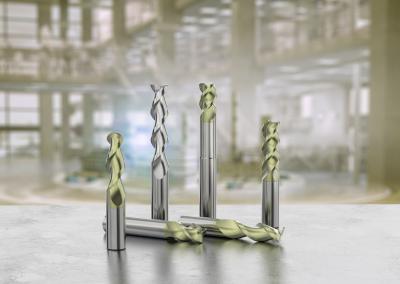
Introducing the new and improved A245/345 product families from Niagara Cutter, a Seco Tools company. These tooling solutions have been redesigned to reduce power consumption and improve chip evacuation in aluminum machining applications.
As described by the North American Solid Milling Product Manager, Jay Ball, “the newly upgraded Niagara Cutter A245/A345 product family solves the power consumption issue that most aluminum manufactures encounter. By combining an engineered flute shape and polished K-land, giving you an optimal combination of helix angle and rake angle, this product family reduces power consumption by a minimum of 20%.”
This product family upgrade also has the latest in engineered PVD coatings called ANF (Aluminum Non- Ferrous). “This is a truly unique coating,” Ball describes, “it reduces friction and built-up material on the cutting edge, which improves workpiece surface finish and increases tool life, removing surface finish quality issues when milling aluminum.” This can greatly increase the product's tool life as compared to uncoated and TiCN coated solutions.
Contact Details
Related Glossary Terms
- gang cutting ( milling)
gang cutting ( milling)
Machining with several cutters mounted on a single arbor, generally for simultaneous cutting.
- helix angle
helix angle
Angle that the tool’s leading edge makes with the plane of its centerline.
- milling
milling
Machining operation in which metal or other material is removed by applying power to a rotating cutter. In vertical milling, the cutting tool is mounted vertically on the spindle. In horizontal milling, the cutting tool is mounted horizontally, either directly on the spindle or on an arbor. Horizontal milling is further broken down into conventional milling, where the cutter rotates opposite the direction of feed, or “up” into the workpiece; and climb milling, where the cutter rotates in the direction of feed, or “down” into the workpiece. Milling operations include plane or surface milling, endmilling, facemilling, angle milling, form milling and profiling.
- physical vapor deposition ( PVD)
physical vapor deposition ( PVD)
Tool-coating process performed at low temperature (500° C), compared to chemical vapor deposition (1,000° C). Employs electric field to generate necessary heat for depositing coating on a tool’s surface. See CVD, chemical vapor deposition.
- rake
rake
Angle of inclination between the face of the cutting tool and the workpiece. If the face of the tool lies in a plane through the axis of the workpiece, the tool is said to have a neutral, or zero, rake. If the inclination of the tool face makes the cutting edge more acute than when the rake angle is zero, the rake is positive. If the inclination of the tool face makes the cutting edge less acute or more blunt than when the rake angle is zero, the rake is negative.
- titanium carbonitride ( TiCN)
titanium carbonitride ( TiCN)
Often used as a tool coating. See coated tools.

